| Article ID | Journal | Published Year | Pages | File Type |
|---|---|---|---|---|
| 4366624 | International Journal of Food Microbiology | 2015 | 4 Pages |
•Study showed a low frequency of AMR among Salmonella enterica isolates.•A low frequency of Salmonella isolates harboured AMR genes and a class 1 integron.•The most commonly detected AMR genes were blaTEM, tet A and dhfrV.•The low frequency of AMR among Non Typhoidal Salmonella isolates represents minimal public health risk.
This study was conducted to examine the antimicrobial resistance (AMR) of Salmonella spp. isolated from commercial caged layer flocks in New South Wales and South Australia. All Salmonella isolates (n = 145) were subjected to phenotypic and genotypic characterisation of AMR and carriage of integrons. The majority of Salmonella isolates (91.72%) were susceptible to all antimicrobials tested in this study. Limited resistance was observed to amoxicillin and ampicillin (5.51%), tetracycline (4.13%), cephalothin (2.06%) and trimethoprim (0.68%). None of the isolates were resistant to cefotaxime, ceftiofur, ciprofloxacin, chloramphenicol, gentamycin, neomycin or streptomycin. A low frequency of Salmonella isolates (4.83%) harboured antimicrobial resistance genes and a class 1 integron. The most commonly detected AMR genes among the Salmonella isolates were blaTEM (2.07%), tet A (1.38%) and dhfrV (0.69%). Overall, Salmonella enterica isolates exhibited a low frequency of AMR and represent a minimal public health risk associated with the emergence of multidrug resistant Salmonella spp. from the Australian layer industry.
